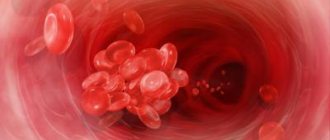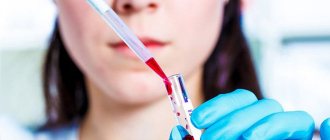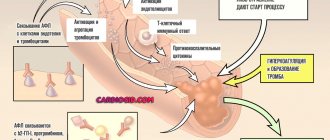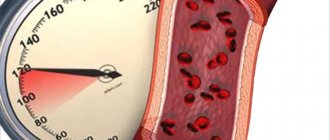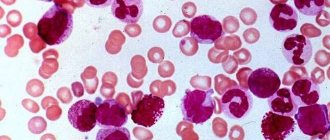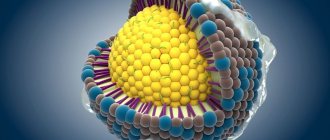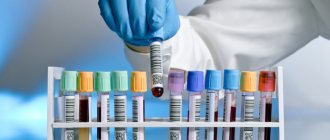What are ALT and AST
ALT (alanine aminotransferase) and AST (aspartate aminotransferase) are enzymes that are present in the tissues of many organs. They are involved in protein metabolism and the formation of amino acids, and changes in their levels in the blood are a marker of the development of somatic diseases. Low enzyme activity is also observed in the blood of a healthy person.
The highest concentration of these compounds was found in the heart muscle. Thus, AST activity in the myocardium is 10 thousand times higher than in blood serum.
Enzymes are also found in such organs as (in descending order of their content):
- liver;
- skeletal muscles;
- pancreas, spleen and lungs;
- brain;
- kidneys
ALT is considered a marker enzyme for the liver, and AST for the myocardium. In cells, they are concentrated in the liquid contents and mitochondria (cellular “energy” stations), respectively, and by their ratio one can judge the degree of damage to the tissues of these organs.
What is ALT?
ALT acts predominantly in the cytoplasm of hepatocytes, in the epithelium of the renal glomeruli, and slightly less in the heart. During developing destructive processes at the cellular level, Alt is released from them and penetrates into the bloodstream, where its increase is detected. The growth of ALT directly depends on the degree of organ damage and is an important indicator of necrotic changes in organ tissue.
In viral hepatitis, the degree of increase in Alt is proportional to the duration of the disease. In the acute course of the disease, enzyme activity exceeds the norm ten times or more. The growth of Alt in the viral form is detected very early - even before the appearance of jaundice. Its activity also increases in those suffering from the anicteric form. With effective therapy, ALT gradually decreases. However, a rapid decrease in Alt with increasing hyperbilirubinemia is a symptom of an unfavorable course of the disease.
In some cases, Alt may rise for no apparent reason. Also, ALT values change in a healthy person during the day: lower concentrations are recorded in the early morning, higher concentrations in the afternoon.
Article on the topic:
How to independently apply for a sanatorium-resort card at a clinic under a compulsory medical insurance policy?
Normal values of ALT and AST in women
ALT, the norm for women by age is indicated in the table later in the article, is most often determined by the colorimetric method (kinetic UV method). Enzyme concentration is measured by measuring the optical density of a mixture of blood serum and a chemical reagent. Some laboratories use spectrographic and spectrophotometric research methods.
Normal blood enzyme values for women according to the kinetic UV method are in the following range:
| Age, years | Maximum ALT value, U/l | Maximum AST value, U/l |
| Newborns up to 5 days | 49 | 97 |
| Newborns from 5 days to 6 months | 56 | 77 |
| < 1 | 54 | 82 |
| 1-3 | 33 | 48 |
| 3-6 | 29 | 36 |
| 6-12 | 39 | 47 |
| 12-17 | 24 | 25 |
| Over 17 | 31 | 31 |
Norms of ALT and AST in the blood (tables by age)
Among women
Normal levels of ALT and AST in the blood of women:
- for ALT - from 0 to 35 U/l;
- for AST - from 0 to 31 U/l.
Alt and Ast are normal in the blood of women by age - table:
| Age | ALT | AST |
| newborns | 48 | 25-75 |
| 4-6 months | 55 | 15-60 |
| 3 years | 32 | 15-60 |
| 6 years | 28 | 15-60 |
| 11 years | 38 | 15-60 |
| from 18 | up to 35 | up to 31 |
With age, the level of transferases in women gradually decreases. For example, the upper limit of ALT in healthy women after 50 reaches 28 U/l, and by old age it varies from 5 to 24 U/l.
There are some factors that can affect the transferases of a healthy woman, causing them to fluctuate within 30%. These are the factors:
- 1st trimester of pregnancy;
- excess body mass index;
- alcohol and drug use;
- taking certain medications;
- physical activity, overwork, lack of sleep;
- stress, emotional arousal.
In men
Due to the fact that the percentage of muscle mass in men is higher than in women, then, accordingly, the proportion of ALT and AST enzymes entering the circulatory system in a man who does not suffer from any pathologies will be slightly higher.
Why do enzyme levels change?
ALT and AST are intracellular enzymes, so their levels in the blood should normally be low. When cells in tissues rich in these substances are damaged and destroyed, they are released and enter the human bloodstream.
However, these enzymes do not have narrow specificity (since they are present in a number of organs), so an increase in their serum activity does not always correspond to the severity of the lesion.
ALT/AST norm in women by age depends on lifestyle
Women have slightly lower enzyme concentrations than men. An increase in the level of ALT and AST is also observed under certain physiological conditions in healthy people: when following a high-protein diet, when consuming foods rich in sucrose, as well as in donors who regularly donate blood; with heavy physical activity and malnutrition.
Increased ALT
An increase in the level of ALT (this enzyme can be otherwise designated in tests as ALT, SGPT, Alanine aminotransferase) is observed in the following diseases and pathological conditions:
- Diseases of the hepatobiliary system:
- viral hepatitis;
- toxic liver damage as a result of poisoning with poisons, drugs, plant and fungal toxins, alcohol, after radiation exposure;
- cirrhosis of the liver;
- obstructive jaundice, which occurs when the bile ducts are obstructed as a result of their blockage with stones or spasms;
- liver cancer;
- fatty hepatosis (accumulation of fat in liver tissue), observed in alcoholism, diabetes mellitus, thyroid pathologies and other metabolic disorders.
- Cardiovascular diseases:
- heart failure;
- myocardial infarction;
- inflammation of the heart muscle of a rheumatic, infectious or allergic nature;
- hemolytic pathologies (these enzymes are also present in erythrocytes).
- Other violations:
- pancreatitis;
- shock;
- hypoxia (oxygen starvation of tissues);
- severe injuries and extensive burns;
- muscle dystrophy;
- Infectious mononucleosis;
- alcoholic delirium;
- filariasis (helminthic infestation);
- preeclampsia (a sharp increase in blood pressure during pregnancy or childbirth);
- inflammation of skeletal muscles.
The most pronounced increase in ALT concentration is observed in liver diseases - it can exceed the norm by up to 100 times or more. In this case, the degree of increase in enzyme activity is proportional to the severity of damage to a given organ. With viral hepatitis, this change in the blood can be detected in the initial stages, when there is no jaundice yet.
Elevated AST readings
The AST value in the blood increases in the following cases:
- Pathologies of the hepatobiliary system:
- acute, malignant hepatitis, accompanied by massive liver necrosis;
- violation of the outflow of bile in cholelithiasis, opisthorchiasis, dyskinesia and cysts of the biliary tract, infectious and endocrine diseases;
- alcoholic hepatitis;
- tumors in the liver.
- Diseases of the cardiovascular system:
- acute myocardial infarction;
- heart failure;
- stroke;
- thalassemia (hereditary disease associated with impaired hemoglobin production);
- hemolytic anemia.
- Other pathologies:
- Infectious mononucleosis;
- pulmonary embolism;
- pulmonary tuberculosis;
- inflammatory diseases of muscle tissue;
- heat stroke and extensive burns;
- muscular dystrophy;
- small intestinal infarction;
- infectious diseases, sepsis;
- metabolic disorders - hypothyroidism (reduced production of thyroid hormones), lactic acidosis, obesity, Wilson-Konovalov disease, Gaucher disease.
Both markers are elevated
ALT, the norm in women by age after 17 years does not change, increases significantly along with AST in case of liver damage (hepatitis, cirrhosis).
This symptom is also observed in diseases such as:
- acute pancreatitis;
- inflammation of the gallbladder;
- parasitic and infectious pathologies (ARVI, toxoplasmosis);
- extensive burns.
In liver cirrhosis, AST levels are usually higher than ALT. When this organ is damaged, the activity of the first type of enzyme increases faster than the second type.
Why are liver transaminases elevated during pregnancy?
In pregnant women, increases in AST and ALT levels may be physiological, associated with increased load on the liver to remove fetal waste products. If the examination does not confirm any of the above diagnoses, then this condition does not require treatment. However, an increase in enzyme activity may also indicate the development of pathology.
The most common of them among pregnant women are:
- Cholestatic hepatosis, in which pathological changes occur in the liver tissue and the process of formation and excretion of bile is disrupted. Risk factors are: use of oral contraceptives before conception, multiple pregnancies, IVF. Often this disease also occurs against the background of infections - viral hepatitis, infection with the Epstein-Barr virus, cytomegalovirus.
- Conflict of Rh factors in the blood of mother and fetus.
- Cholecystitis and bile stagnation.
- Kidney failure.
When AST and ALT levels increase by 10-20 times, it is necessary to undergo examination for the presence of viral hepatitis and autoimmune liver diseases.
Causes of decreased liver enzymes
A decrease in alanine aminotransferase and aspartate aminotransferase activity may occur in the following cases:
- with renal failure;
- for malaria;
- during pregnancy;
- with a lack of vitamin B6 in the body;
- with repeated hemodialysis - blood purification through a special device.
Isolated change in ALT
ALT is also activated when released from destructively altered cells. Typically, an increase in ALT is caused by:
- liver diseases - viral and alcoholic hepatitis, fatty hepatosis, cirrhosis, cancer;
- heart disease - heart attack (minor), myocarditis, and other diseases that occur with the destruction of myocardial cells;
- severe poisoning and extensive burns , as well as injuries with damage to muscle tissue;
- acute pancreatitis;
- autoimmune thyroiditis;
- intrahepatic cholestasis:
- myositis.
Elevated ALT is recorded in obesity (2-3 times), with progressive leukemia, and cancer.
Article on the topic:
Ketone bodies in urine - what does this mean?
When is a test ordered?
An analysis to detect the level of ALT and AST is prescribed in the following cases:
- Detection of myocardial infarction, which is not detected on the ECG. In this case, AST increases in the first 4-6 hours after the attack and normalizes on days 3-7. A severe course of the disease is indicated by: ALT is 10 or more times higher than normal, AST is 20 or more times higher than normal.
- Diagnosis of liver pathologies. The ratio of AST to ALT in this case is usually less than 1.33.
- Examination of people in contact with patients with viral hepatitis.
- Checking the condition of donors before donating blood.
- Monitoring certain medications and their effects on the liver.
A referral for analysis can be issued by both a general practitioner and highly specialized specialists - a cardiologist, gastroenterologist, surgeon, hematologist.
Why are liver transaminases elevated during pregnancy?
In the first months of gestation, the activity of ALT and AST in the blood increases. The increase in enzyme levels is affected by:
- altered hormonal levels;
- early toxicosis;
- psycho-emotional overexcitation;
- taking vitamin and mineral complexes.
In the last stages of pregnancy, many women experience gestosis, a pathological condition that is accompanied by increased blood pressure, swelling of the extremities, nausea, etc. Excessive protein excretion in the urine leads to an increase in ALT in the blood. But if the concentration of transaminases changes by 15-30%, treatment is not carried out.
If the activity of liver enzymes exceeds the norm by 10 times or more, pregnant women are prescribed a comprehensive diagnosis.
How to prepare for research
To obtain reliable results, you must follow the following rules for preparing for blood donation:
- The last meal is 8-14 hours before taking biomaterial (after a period of overnight fasting). Sometimes the doctor may prescribe a test during the day, in which case the last light meal is 4 hours before. You can drink water.
- 1 day before visiting the laboratory, the following factors must be excluded:
- increased physical activity (including sports training);
- emotional stress;
- drinking alcohol.
Transferase levels may also be affected by taking certain medications (listed below), so you should notify your doctor about this and agree with him about their temporary withdrawal.
How to properly donate blood for analysis of ALT and AST
So that there is no doubt about the truth of the indications for donating blood for AST, ALT needs to be prepared. The day before the test, you need to exclude sports training and any increased stress, you should not drink alcohol or worry. Dinner should be light without fatty or fried foods.
The time of dinner must be calculated so that you do not eat anything for 14 hours before blood donation.
You can drink water. Blood donation is carried out in the morning on an empty stomach. If, according to indications, blood donation is carried out during the day, blood donation should be preceded by at least 4 hours of fasting after a light meal.
For the study, venous blood is taken in the morning on an empty stomach. Serum and plasma are examined in the laboratory.
How is biomaterial collected from a vein?
ALT and AST are determined in venous blood. The norm for women by age should be indicated on the medical form along with the actual value obtained.
The procedure for collecting biomaterial is standard and includes the following steps:
- The subject is seated on a chair, his left hand is placed on the table.
- The technician applies a tourniquet above the elbow to ensure blood flow to the vein. The patient is asked to work with his hand (clench and unclench his fist several times).
- The puncture site (elbow) is treated with a cotton swab with alcohol or a special napkin.
- The laboratory technician inserts a disposable needle into a vein and draws blood into a test tube. The tourniquet is loosened.
- After filling the tube, the needle is removed, and a tampon or napkin is again applied to the puncture site. It must be pressed well for 5-10 minutes to completely stop the bleeding.
Decoding analysis responses
Despite the fact that the activity of ALT and AST is not specific for liver pathologies, the main purpose of the study is to identify pathologies of this particular organ.
Combined assessment of AST and ALT helps diagnose myocardial infarction. However, the diagnosis cannot be made using these two criteria alone. They are used at the first stage of diagnosis. The doctor can make a final decision only on the basis of a combination of instrumental and laboratory data.
In liver cirrhosis, enzyme levels can range from the upper limit of normal to a 4-5-fold increase, with AST being higher. If there are malignant tumors in this organ, their concentration, as a rule, exceeds 5-10 times the normal value.
To clarify liver pathology, a specific analysis is performed for the presence of hepatitis viruses (ELISA, PCR), as well as ultrasound of the abdominal organs, which allows one to assess the degree of degenerative changes in the organ.
What could affect the validity of the study?
The results of the analysis may be affected by violation of the rules for preparing for the test, as well as taking the following medications:
- antibacterial agents (sulfonamides, penicillins, tetracyclines and others);
- barbiturates (Phenobarbital, Barbital, Butizol and others);
- opiates, anesthetics;
- drugs to reduce the concentration of lipids in the blood (Simvastatin, Atorvastatin, Lovastatin and others);
- medications containing acetylsalicylic acid, indomethacin and other hepatotoxic components;
- oral contraceptives and other hormonal agents - testosterone, androgens, progesterone.
Rules for taking the analysis
The analysis is carried out in any public clinic and private laboratory.
To get reliable transferase test results, women follow the following rules:
- Do not eat 8-12 hours before the test.
- Avoid any physical activity or overexertion 30 minutes before the test.
- Eliminate psychological stress 30 minutes before the test.
- Stop smoking 30 minutes before the test.
- Avoid drinking alcohol and fried foods the day before the test.
- Warn the specialist about the medications you are taking.
Drug treatment of diseases depending on the test results
Treatment tactics for elevated AST and ALT values depend on the underlying cause of this symptom and the severity of the disease. So, for mild viral hepatitis, choleretic agents and multivitamins are prescribed. If hepatitis occurs in a severe form, then the use of antiviral drugs, hormonal, detoxification, and antibacterial therapy is necessary.
One of the main groups of drugs that are used for all liver lesions are hepatoprotectors:
- based on silibinin (Karsil, Silibor, Siliverin, Hepatofalk and other products);
- based on essential phospholipids (Essentiale forte, Essentialcaps, Phosphogliv and others).
Galstena
Galstena is a homeopathic medicine, the main components of which are:
- milk thistle, which contains substances that help restore liver cells;
- dandelion, the herb of which has a choleretic effect;
- greater celandine (choleretic and bactericidal effect in pathologies of the liver and gall bladder);
- sodium sulfate, which stimulates epithelial cells of the biliary tract and pancreatic ducts;
- phosphorus, which has an inhibitory effect on the development of cancer cells.
It is used in complex therapy for the treatment of hepatitis, cholecystitis, pancreatitis in the following single dosage (no more than 4 doses per day):
- adults – 10 drops;
- children:
- 5-12 years – 5-7 drops;
- 1-5 years – 2-4 drops;
- up to 1 g – 1 drop.
Gepabene
The main active components of Gepabene capsules are the fruits of spotted milk thistle and the herb medicinal fume, which contains alkaloids that help normalize the functioning of the gallbladder and its ducts.
This plant-based drug is prescribed only to adults as part of complex therapy for chronic hepatitis and toxic liver damage, as well as to eliminate biliary dyskinesia. It is contraindicated in acute hepatobiliary diseases.
Gepabene is taken three times a day, 1 capsule; if necessary, the maximum daily dosage can be increased to 6 capsules.
Karsil
The drug Karsil is also made on a plant basis. The main component of the pills and capsules is the dry extract of the fruits of spotted milk thistle, which promotes the rapid restoration of liver cells and metabolism. Unsaturated fatty acids in the extract also help reduce the level of “bad” cholesterol.
This drug is prescribed for liver damage of any etiology, as well as for the prevention of atherosclerosis.
Dosage regimen:
- for adults – 1-2 tablets (dragées) 3 times a day;
- for children 5-12 years old – 3 mg per 1 kg of weight, in 3 doses per day.
Essentiale
Essentiale is available in the form of sachets, capsules and solution for intravenous administration. The basis of this drug is essential phospholipids, which help restore cell membranes in liver tissue and stimulate the activity of enzyme systems.
Capsules are prescribed to patients over 12 years of age (body weight must be more than 43 kg) 2 pieces. 3 times a day. The main contraindications include intolerance to phosphatidylcholine and soy.
Diet and exercise
ALT, the norm for women by age is indicated in the article, is normalized after treatment of the underlying disease. One of the important components of complex therapy is diet.
Patients with liver pathologies must adhere to the following dietary recommendations:
- for a mild form of the disease - table No. 5 according to Pevzner, for a severe form - No. 5a;
- Drinking plenty of fluids is indicated, which should be reduced after the urine becomes light;
- when liver cirrhosis is combined with ascites, reduce the use of table salt;
- if the disease is infectious and after surgery, the daily diet should contain at least 1.8 g of protein per 1 kg of the patient’s weight (protein diet).
Features of table No. 5 are as follows:
- meals - at least 5 times a day;
- It is preferable to cook steamed and boiled dishes;
- Alcohol, fatty foods (animal fats), rich broths, spicy, salted, smoked, fried, marinades, fresh yeast baked goods, vegetables that irritate the gastrointestinal mucosa (radishes, radishes, onions, cranberries and others) are completely excluded;
- Porridge, lean meat and fish, pasta, vegetarian soups, vegetables and fruits (except for sour ones) are allowed.
In the acute period, bed rest is indicated, then half-bed rest, and during the period of remission, moderate physical activity.
Folk remedies for normalizing enzyme levels in the blood
In folk medicine, the following recipes are used to normalize liver function:
- Milk thistle tea. 1 tsp. powder of plant seeds or herbs pour 1 tbsp. boiling water, leave for 20 minutes. Drink tea ½ tbsp. in the morning on an empty stomach, before lunch and dinner, for 2 weeks, then take a break.
- 1 tbsp. l. pour 0.5 liters of clean water over unpeeled oat grains and leave overnight. In the morning, boil in the same water for 2 minutes, reduce heat and simmer for another 5 minutes, covering with a lid. Turn off the heat and leave for 10 minutes. Strain and drink this remedy ½ tbsp. 3 times before meals for 10 days.
- Separate corn silk from 2 large cobs. Pour 1.5 liters of boiling water over them, leave for 20 minutes, then strain. The infusion is drunk as tea throughout the day. The course of treatment is 1 month, then a break for 2 months.
- After taking corn silk, it is recommended to continue therapy with an infusion of citvar wormwood, which is prepared using the same method. It is taken for a month, ½ tbsp. 2 times a day.
Possible consequences of elevated enzyme levels
ALT, the norm in women by age should not exceed 31 units for patients over 17 years of age, does not in itself pose a threat to health. Complications and prognosis depend on the type of disease diagnosed and the severity of its course. So, if this condition is caused by physiological reasons, then treatment is not required and the activity of AST and ALT normalizes on its own.
With myocardial infarction, one of the most serious complications is cardiac arrest, and with cirrhosis of the liver - the development of carcinoma and liver failure, also leading to death.
Cholestatic hepatosis in pregnant women can cause the following negative phenomena:
- fetal hypoxia;
- premature birth and miscarriage;
- postpartum bleeding.
ALT is an enzyme that serves as one of the main markers of pathologies of the liver, pancreas, heart and other organs. Exceeding the norm in women by age requires additional instrumental and laboratory diagnostics to identify the cause that caused such a deviation.
Changes in enzyme activity can also be associated with physiological reasons and the use of certain medications, so in some cases the test is repeated.
Article design: Vladimir the Great


